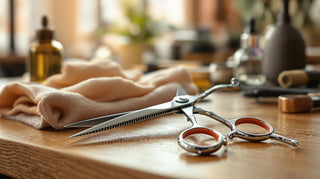Proper care can extend the life of your hair shears, keeping them sharp, functional, and reliable. Neglecting maintenance can lead to dull blades, corrosion, and poor cutting results. Here's a quick guide to shear care:
- Daily Cleaning: Wipe shears after each use, sanitize with alcohol, and store them in a protective case.
- Oil Regularly: Apply professional shear oil to the pivot point daily or after every 2–3 uses.
- Check Tension: Adjust the tension screw to ensure smooth cuts and avoid unnecessary wear.
- Sharpening: Have shears professionally sharpened every 6–12 months, depending on usage.
Simple habits like these not only save money on replacements but also ensure top-notch performance for your clients. Read on for detailed tips and techniques to care for your tools effectively.
How to Clean & Oil Your Haircutting Shears
Basic Daily Care
Taking care of your shears every day helps maintain their sharp edge and reduces wear. Simple cleaning and proper storage can go a long way in keeping these tools in top condition.
Post-Use Cleaning Steps
"Hair shears should be cleaned after every use to remove hair, oils, and product residue that can dull the blades or cause corrosion."
Here’s what to do after each use:
- Wipe them down: Use a soft, clean cloth to remove any debris immediately.
- Sanitize properly: Apply rubbing alcohol or a disinfectant specifically designed for shears.
Drying and Storage Basics
Once cleaned, drying and storing your shears correctly is just as important. As Osaka Scissors puts it:
"Moisture is among the worst enemies when it comes down to maintaining sharpness on shear blades."
To keep your shears in great shape, follow these steps:
- Dry completely: Use a paper towel to remove moisture, then let them air dry for 30–60 minutes.
- Use a protective case: Store shears in a dedicated case to avoid damage.
- Keep blades open: This reduces pressure on the edges and helps maintain sharpness.
For added protection, consider these storage options:
| Storage Method | Benefits | Best For |
|---|---|---|
| Individual Cases | Prevents damage and controls moisture | Daily use |
| Drawer Partitions | Keeps shears organized and separated | Multiple shears |
| Tool Cabinet | Offers professional organization | Salon environment |
Oil and Tension Maintenance
Taking care of your shears involves more than just cleaning and storage. Regular oiling and tension adjustments help prolong their lifespan and keep them performing at their best.
How to Oil Your Shears
Oiling prevents rust and ensures smooth operation. According to Stay Sharp Shears:
"Daily oiling and cleaning will enhance the performance and extend the cutting life of your shears."
Here’s a simple oiling schedule:
| Usage Level | Oiling Frequency | Additional Step |
|---|---|---|
| Daily Use | Once per day | Oil after cleaning |
| Occasional Use | Every 2–3 uses | Oil after sanitizing |
Follow these steps to oil your shears properly:
- Hold the shears with the tips pointing downward at about a 45-degree angle.
- Add 2–3 drops of professional shear oil to the pivot point.
- Open and close the blades a few times to distribute the oil evenly.
- Let the shears sit overnight.
- The next morning, open and close the blades again to clear out any trapped hair or debris.
Setting Correct Blade Tension
Proper blade tension is key to clean cuts and reducing wear. You can test your shears' tension with this simple method:
- Hold the shears vertically with the tips pointing upward.
- Open one blade to a 90-degree angle.
- Let go of the handle.
- Watch how the blade moves - it should close slowly without snapping shut.
If adjustments are needed, turn the tension screw clockwise to tighten or counterclockwise to loosen. Make small adjustments and check the tension daily, especially during the first two months of use. As Sharpen-This explains:
"Most cutting problems with otherwise sharp shears are due to tension, so make sure you check it daily!"
sbb-itb-a50b05d
Sharpening and Service
When to Sharpen Blades
Keeping shears sharp ensures they perform well. If your shears start snagging or pulling hair, it’s time for sharpening .
Home vs. Professional Sharpening
Here’s how professional sharpening stacks up against doing it yourself:
| Aspect | Professional Service | Home Sharpening |
|---|---|---|
| Cost | $39.00 (includes shipping) | Upfront cost for tools |
| Process | Full disassembly, cleaning, sharpening, honing, reassembly, and oiling | Basic sharpening only |
| Risk | Low risk with certified technicians | Higher chance of blade damage |
| Quality Control | Expert tools and knowledge | Limited by personal equipment |
| Extras | Includes cleaning, oiling, and tension adjustment | Depends on available tools |
Professional services go beyond simple sharpening. According to Scissor Mall:
"We recommend having any shears that you use on a regular basis serviced at least once a year. They need to be cleaned, set and balanced, even if they are still sharp within that year period."
Sharpening Time Intervals
How often you need to sharpen depends on how often you use your shears and their quality. Use this guide to plan:
| Usage Level | Shear Quality | Recommended Interval |
|---|---|---|
| Heavy Professional | Premium | Every 6-12 months |
| Daily Use | Standard | 3-4 times per year |
| Part-time Use | Premium | Once a year |
To make your shears last longer between sharpenings, follow these tips:
- Clean them after every use
- Oil them at least weekly
- Check and adjust tension regularly
High-quality shears need sharpening less often because of their superior steel. By keeping them in good shape, you’ll maintain their performance - and be ready to learn about proper handling techniques next.
Safe Handling Methods
Proper Grip and Cutting
Using the right grip not only protects your tools but also reduces hand fatigue. Place your ring finger on the top handle, your thumb on the bottom handle, and let the rest of your fingers rest outside the ring. When opening and closing the shears, only your thumb should move .
Focus on moving your thumb in a strictly vertical motion. This helps minimize unnecessary movement and reduces strain on your hand.
In addition to mastering the grip, it’s crucial to avoid common mistakes that can shorten the lifespan of your shears.
Common Damaging Practices
Even with a proper grip, there are handling habits that can harm your shears. Here are some frequent mistakes and how to prevent them:
| Damaging Practice | Impact | Prevention |
|---|---|---|
| Horizontal Thumb Pressure | Leads to blade misalignment and hand fatigue | Stick to vertical thumb movement |
| Improper Grip Form | Causes uneven wear and added strain | Ensure correct finger positioning |
| Using Dull Blades | Requires excessive force, risking damage | Regularly sharpen your shears |
| Improper Storage | Causes blade damage and misalignment | Use a protective case for storage |
To keep your shears in top condition, clean and sanitize them after each client, oil them daily after cleaning, and use them exclusively for cutting hair. If wrist strain becomes an issue, consider switching to offset shears for better ergonomics .
Storage and Travel Tips
Taking care of your shears doesn't stop at cleaning and handling. Proper storage and travel practices can make a big difference in keeping them in top shape.
Using Protective Cases
Did you know that 37% of high-end shears are damaged within their first year due to falls or corrosion? A quality protective case is a simple way to prevent this.
Here are some popular case options and their benefits:
| Case Type | Ideal For | Benefits |
|---|---|---|
| Leather Wallets | Multiple shears | Roll-up design, premium padding |
| Hard Shell Cases | Travel/transport | High impact resistance |
| Zippered Cases | Daily use | Shields against water and chemicals |
| Soft Pouches | Single shears | Lightweight and easy to carry |
For example, the Japan Scissors – 4pcs Black Leather Scissors Wallet ($219.00) offers excellent protection for multiple tools, while the Travel Scissors Roll Bag ($49.00) is a more budget-friendly option . Whether you're at home or on the go, these cases provide peace of mind for your tools.
Travel Protection Methods
When traveling with shears, safety and proper storage are key. Here's how to protect them based on your travel needs:
- Local Travel: Use padded cases, avoid storing tools in humid areas, and secure them with magnetic strips if needed for temporary storage.
- Air Travel: Always place shears in your checked luggage. Wrap or sheath the blades securely to avoid accidents, and opt for hard-shell cases with locks for added security.
For professionals who frequently move between locations, the Premium Black Scissor Wallet ($119.00) is a great choice. Its 8-piece roll-up design includes padded compartments to keep your tools safe and organized without taking up much space.
Summary: Long-Term Care Tips
Take care of your shears to keep them performing well over time. Start with daily cleaning - especially after working with chemically treated hair - using a soft, damp cloth. This helps prevent buildup that can dull the blades . Make sure to lubricate the pivot regularly: at least once a week, or daily if you use your shears heavily .
Here’s a simple maintenance schedule to follow and protect your tools:
| Timeframe | Tasks | Purpose |
|---|---|---|
| Daily | Clean & dry | Prevents rust and buildup |
| Weekly | Oil pivot | Minimizes friction |
| Monthly | Check tension | Ensures smooth performance |
| Every 6–12 Months | Professional sharpening | Keeps blades precise |
Pay attention to signs like resistance or scratching and adjust the tension right away if needed . As Scissor Mall advises:
"Shears should be CLEANED at the end of each day, before they are put in their case for the night"
Lastly, store your shears in a sturdy, high-quality case to protect them from damage and moisture .

